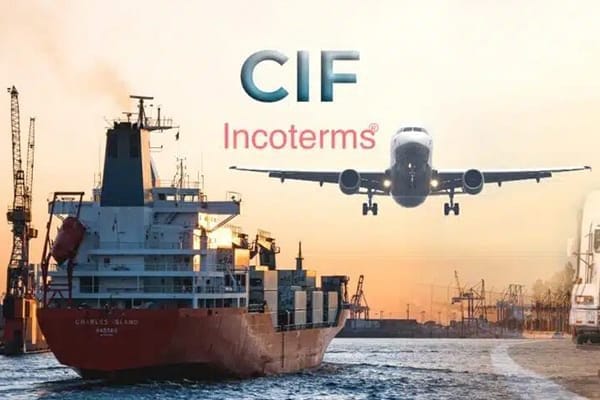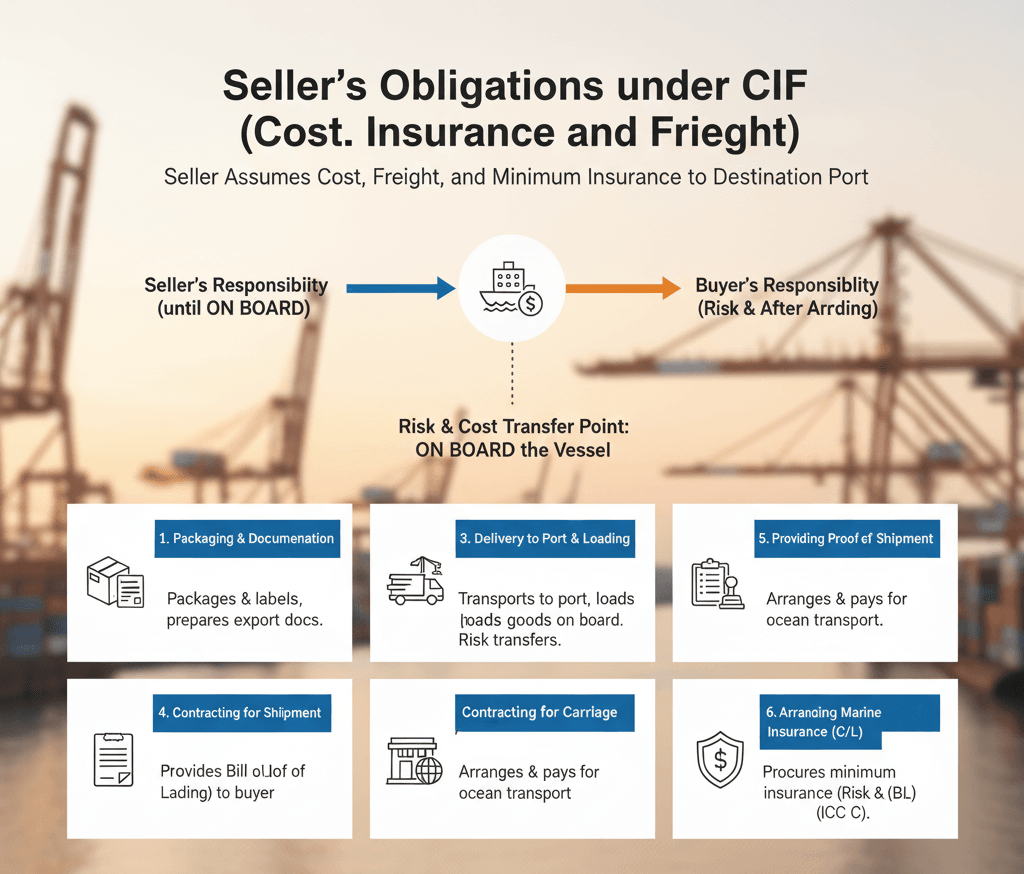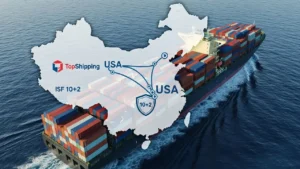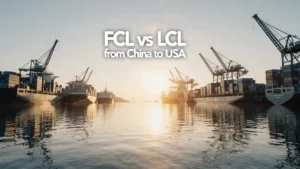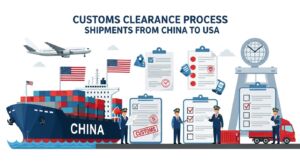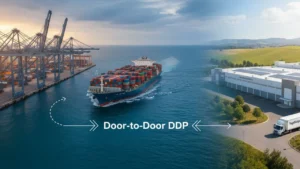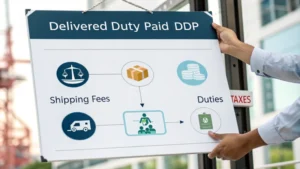Introduction
In the world of international trade, few Incoterms create as much interest and confusion as CIF (Cost, Insurance & Freight).
Under a CIF agreement, the seller is not only responsible for delivering goods and paying for freight, but also for insuring the shipment until it reaches the buyer’s specified port. This combination of cost, carriage, and insurance responsibilities makes CIF a popular choice for maritime transactions and long-distance Shipping Routes.
Yet, despite its frequent use, many traders misunderstand key elements such as the CIF price, CIF invoice, or the delivery CIF process. Understanding how Shipping Routes affect freight costs, transit times, and insurance coverage is essential to applying CIF terms correctly.
The CIF 2020 rules further clarify obligations, risk transfer, and insurance requirements, making it crucial for importers and exporters to understand them accurately.
In this article, we’ll break down the meaning of CIF, explore the obligations of sellers and buyers, examine how and when risk shifts hands, delve into insurance and documentation issues, compare CIF with other Incoterms, and present best practices and real examples. By the end, you’ll have a clear understanding of how CIF works across various Shipping Routes and whether it’s the right choice for your trade operations.
What Is CIF ? – CIF Meaning in Shipping
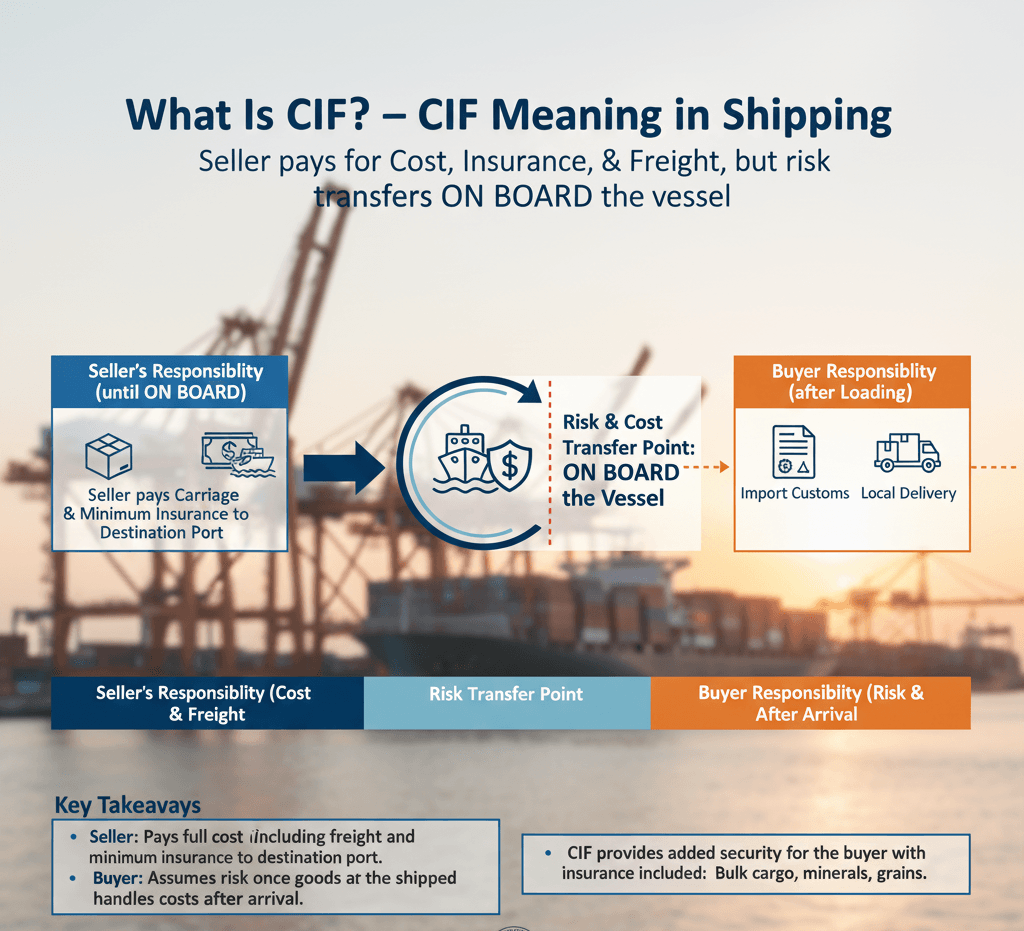
CIF (Cost, Insurance, and Freight) is an Incoterm defined by the International Chamber of Commerce (ICC) under Incoterms 2020, used for sea freight and inland waterway transport.
It means the seller covers the cost of goods, freight, and minimum insurance to the destination port, while the risk transfers to the buyer once the goods are loaded onto the vessel.
Established by the International Chamber of Commerce, the CIF rule ensures consistency and clarity in global shipping practices, helping both parties understand their responsibilities in cost and risk allocation.
CIF Incoterms 2020: Key Updates & Differences
The 2020 revision of CIF (Cost, Insurance, and Freight) under Incoterms® 2020 introduced clarifications to make responsibilities and risk transfer more transparent for both buyers and sellers.
Key updates and differences include:
- Insurance Coverage Requirements: Sellers must now provide minimum insurance coverage according to Clause C of the Institute Cargo Clauses, unless otherwise agreed.
- Delivery and Risk Clarification: Risk still transfers to the buyer once goods are on board the vessel, but the updates emphasize clear documentation to prove shipment.
- Cost and Freight Responsibility: The seller is responsible for freight to the destination port, while buyers handle costs and risks after unloading.
- Alignment with Modern Trade Practices: The 2020 updates better accommodate digital documentation and electronic communication, reducing delays and disputes.
These updates make CIF clearer and more reliable, helping businesses manage obligations, insurance, and logistics efficiently.
When to Use CIF: Scope & Limitations (Sea / Inland Waterway)
CIF (Cost, Insurance, and Freight) is strategically suited for international sea and inland waterway shipments where sellers can efficiently manage both transportation and insurance, reducing the buyer’s logistical burden.
Scope:
- Optimal for bulk commodities, manufactured goods, or high-value cargo, particularly when buyers prefer turnkey logistics solutions.
- Facilitates trade for buyers who lack in-house expertise in freight negotiation or marine insurance procurement.
- Most effective when shipping involves major, well-equipped ports with established maritime infrastructure, ensuring reliability in loading and transit.
Limitations:
- Applicable only to sea or inland waterway transport; CIF is not suitable for multimodal or intermodal shipments.
- Risk transfers at the vessel’s rail in the port of shipment, meaning buyers must remain aware of potential exposure until arrival.
- Sellers provide minimum insurance coverage, often under Institute Cargo Clauses (C), which may be insufficient for high-value, fragile, or temperature-sensitive goods buyers should evaluate additional insurance requirements.
In practice, CIF is a powerful tool for balancing convenience and cost predictability, but it requires both sellers and buyers to have a clear understanding of risk allocation, insurance scope, and port handling responsibilities to optimize international trade efficiency.
Under CIF Incoterms, the seller assumes significant responsibilities, ensuring that goods reach the buyer’s port with minimum risk and compliance. Key obligations include:
Delivery of Goods Onboard the Vessel
The seller must deliver the goods safely on board the vessel nominated by the buyer at the agreed port of shipment. Risk transfers once the goods are loaded.
Payment of Freight Costs
The seller covers all transportation costs to the destination port, ensuring timely and secure shipment.
Arranging Marine Insurance
Sellers must procure minimum insurance coverage (usually under Institute Cargo Clauses C) for the cargo during transit. This protects the buyer against basic loss or damage.
Export Clearance and Documentation
Sellers handle all export formalities, including customs clearance, licenses, and required certificates.
Additionally, they must provide shipping documents (commercial invoice, packing list, Bill of Lading, and insurance certificate) to facilitate smooth import at the destination.
Packaging and Labeling
Proper packaging, labeling, and securing of goods for maritime transport is the seller’s responsibility to prevent damage during handling and shipping.
By fulfilling these obligations, the seller ensures compliance with CIF terms, minimizes disputes, and supports a smooth transfer of goods and risk.
Buyer’s Obligations under CIF (Cost, Insurance and Freight)
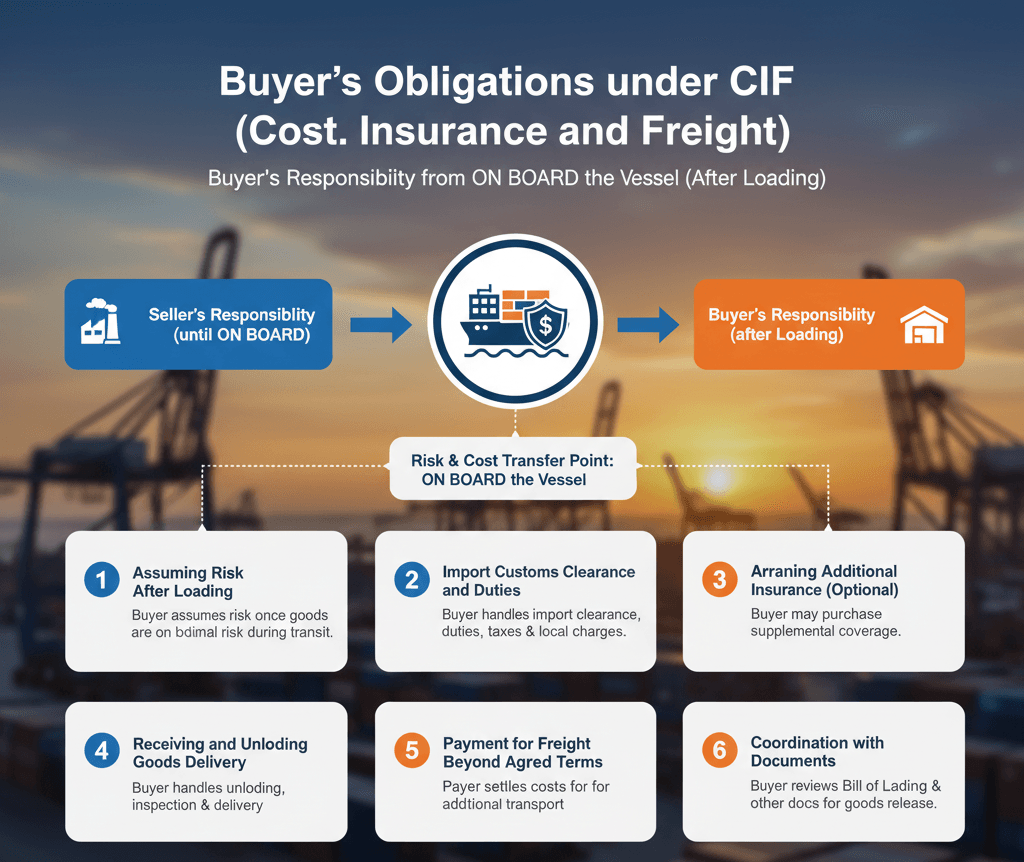
Under CIF Incoterms, the buyer’s responsibilities focus on receiving the goods, handling import formalities, and managing costs beyond the seller’s scope. Key obligations include:
Assuming Risk After Loading
Risk transfers to the buyer once the goods are loaded on the vessel at the port of shipment, even though the seller covers freight and minimum insurance. The buyer must manage any additional risk exposure during transit.
Import Customs Clearance and Duties
The buyer is responsible for import clearance, paying duties, taxes, and any local charges at the destination port.
Arranging Additional Insurance (Optional)
While the seller provides minimum insurance, the buyer may choose to purchase supplemental coverage for high-value, fragile, or temperature-sensitive goods.
Receiving and Unloading Goods
Upon arrival at the destination port, the buyer handles unloading, inspection, and delivery to the final location or warehouse.
Payment for Freight Beyond Agreed Terms
If additional transport or handling costs arise beyond CIF coverage, the buyer is responsible for settling these costs.
By fulfilling these obligations, the buyer ensures efficient import, proper risk management, and compliance with local regulations, making CIF a balanced and reliable Incoterm for international trade.
Transfer of Risk and Cost: Understanding When Liability Shifts under CIF
| Party | Key Responsibilities under CIF |
|---|---|
| Seller | Deliver goods onboard the vessel at the port of shipment Pay for freight to destination port Arrange minimum marine insurance Handle export customs clearance and documentation Proper packaging and labeling |
| Buyer | Assume risk once goods are loaded on the vessel Handle import customs clearance, duties, and taxes Arrange additional insurance if needed Receive, unload, and transport goods to final destination Pay for any extra transport or handling beyond CIF coverage |
CIF Incoterms Price: What It Includes & How It’s Determined?
The CIF price represents the total cost the seller covers to deliver goods to the destination port, including cost, insurance, and freight. Understanding its components helps both buyers and sellers manage budgets and obligations effectively.
Components of CIF Price:
- Cost of Goods: The seller’s production or purchase cost of the goods being shipped.
- Freight Charges: Payment for transporting goods from the port of shipment to the destination port.
- Insurance Premium: Minimum marine insurance covering basic risks during transit (typically under Institute Cargo Clauses C).
How CIF Price is Determined:
- Calculated by adding the cost of goods, freight charges, and insurance premiums.
- Sellers may negotiate freight rates and insurance terms with carriers and insurers to optimize the CIF price.
- Buyers should review the CIF price carefully to ensure it aligns with market rates and meets their risk management needs.
In practice, a well-structured CIF price ensures transparency, reduces disputes, and helps both parties understand financial obligations under the contract.
CIF Incoterms Invoice: Key Components & Best Practices
A CIF invoice is a critical document in international trade that ensures clarity of costs, responsibilities, and shipment details. Proper preparation reduces disputes and facilitates smooth customs clearance.
Key Components of a CIF Invoice:
- Seller and Buyer Details : Names, addresses, and contact information of both parties.
- Description of Goods: Quantity, type, weight, dimensions, and specifications.
- CIF Price Breakdown: Clearly showing cost of goods, freight charges, and insurance premium.
- Port of Shipment and Destination: Exact details to define risk transfer point and logistics route.
- Shipping and Insurance Details : Vessel name, Bill of Lading number, and insurance policy or certificate.
- Payment Terms : Currency, payment method, and deadlines to avoid financial disputes.
- Additional Notes :Any special instructions or references to the contract or Incoterms 2020.
Best Practices:
- Use clear and consistent language to prevent misunderstandings.
- Ensure all dates, numbers, and documentation references are accurate.
- Reference CIF Incoterms 2020 to clearly define obligations.
- Share invoices electronically and in advance to facilitate customs processing.
A professionally prepared CIF invoice enhances transparency, streamlines shipping, and ensures both buyer and seller understand their financial and logistical responsibilities.
Delivery CIF Incoterms and Risk Transfer Point
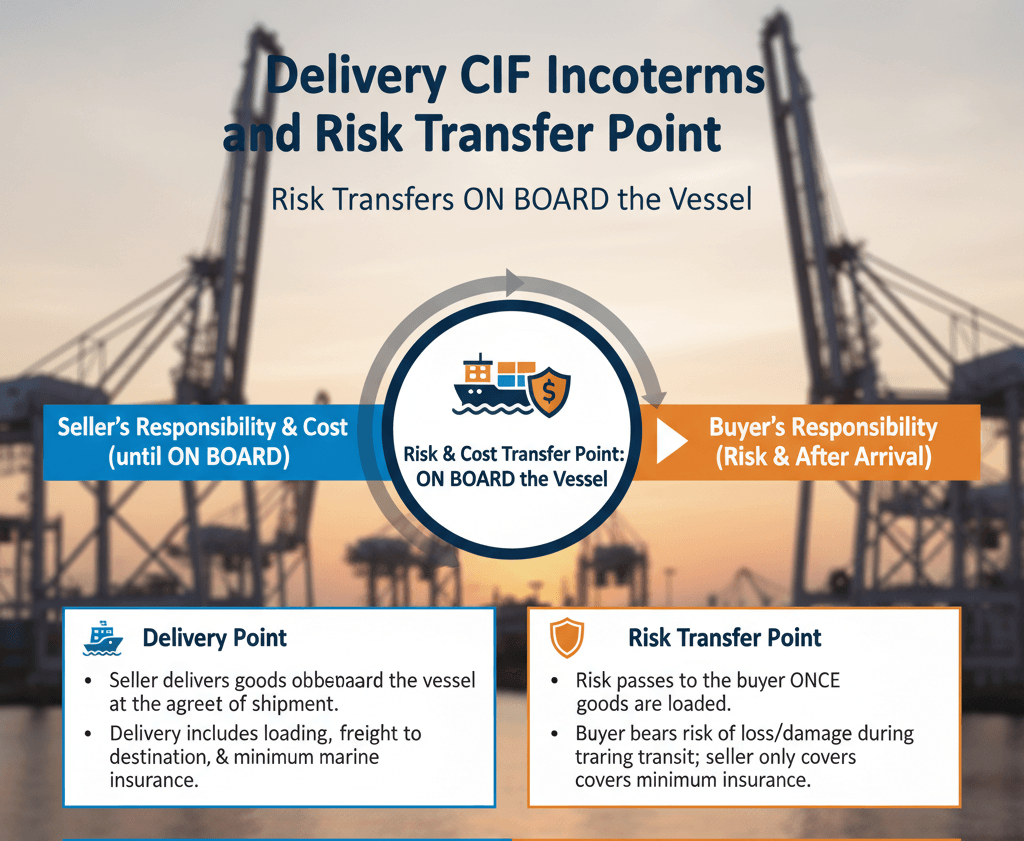
Under CIF (Cost, Insurance, and Freight), understanding delivery obligations and the exact point of risk transfer is crucial for both sellers and buyers.
Key Points:
Delivery Point
- The seller’s responsibility is to deliver goods onboard the vessel at the agreed port of shipment.
- Delivery includes loading the goods, paying freight to the destination port, and arranging minimum marine insurance.
Risk Transfer Point
- Risk passes to the buyer once the goods are loaded onto the vessel, even though the seller covers freight and insurance.
- This means the buyer bears the risk of loss or damage during transit, while the seller is only responsible for minimum insurance coverage.
Implications for Buyers and Sellers
- Buyers should assess the adequacy of insurance and may opt for additional coverage.
- Sellers must ensure proper documentation and compliance with export regulations to avoid delays or disputes.
In practice, CIF clearly separates cost responsibilities from risk exposure, allowing sellers to manage shipping logistics while buyers focus on risk management and import compliance.
CIF Incoterms Insurance: Minimum Cover and Additional Options
Under CIF (Cost, Insurance, and Freight), insurance is a critical element that protects the buyer against loss or damage during maritime transit.
1. Minimum Insurance Coverage:
- Sellers are required to provide basic coverage, usually following Institute Cargo Clauses (C).
- This covers major risks like total loss or damage due to sinking, collision, or fire, but excludes many specific perils.
- The minimum cover ensures compliance with CIF obligations but may not fully protect high-value or sensitive goods.
2. Additional Insurance Options:
Buyers can purchase supplemental coverage to include:
- Partial loss or damage
- Theft, pilferage, or handling damages
- Temperature-sensitive or fragile cargo protection
- Additional insurance gives greater peace of mind and financial protection, especially for high-value or critical shipments.
Key Takeaways:
- CIF ensures buyers have basic protection during transit, while sellers manage insurance procurement.
- Buyers should evaluate the risk profile of their goods and consider enhancing coverage as needed.
- Clear documentation of insurance terms in the CIF invoice and contract is essential to avoid disputes.
CIF Freight and Transport : Who Organizes and Bears Cost
Under CIF (Cost, Insurance, and Freight), understanding freight responsibilities and cost allocation is essential for smooth international trade.
1. Seller’s Responsibilities:
- The seller arranges and pays for ocean freight from the port of shipment to the destination port.
- Ensures goods are properly loaded, documented, and insured for transit.
- Handles coordination with carriers and port authorities to avoid delays.
2. Buyer’s Responsibilities:
While the seller covers freight cost, the risk transfers to the buyer once the goods are onboard the vessel.
The buyer is responsible for unloading, import clearance, duties, and further transportation beyond the destination port.
Key Takeaways:
CIF allows sellers to manage logistics and freight payments, simplifying the process for buyers.
Buyers must remain aware that financial responsibility for insurance is limited to minimum coverage, and risk exposure starts at loading.
Clear contractual terms regarding freight, risk transfer, and documentation prevent disputes and ensure accountability.
Comparisons: CIF vs CFR vs FOB vs CIP
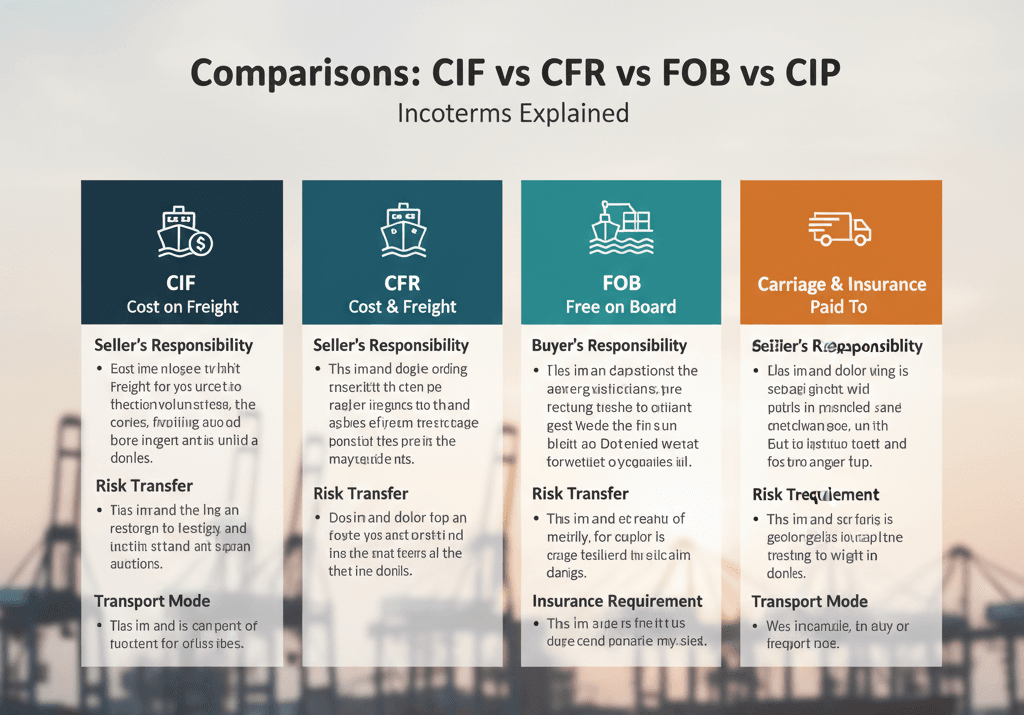
Understanding the differences between major Incoterms helps businesses choose the most suitable shipping arrangement.
| Incoterm | Seller’s Responsibility | Buyer’s Responsibility | Risk Transfer | Insurance Requirement | Transport Mode |
|---|---|---|---|---|---|
| CIF (Cost, Insurance, Freight) | Goods, freight, minimum insurance to destination port | Unloading, import duties, additional insurance | Once goods are loaded on vessel | Minimum marine insurance required | Sea / Inland Waterway |
| CFR (Cost & Freight) | Goods and freight to destination port | Unloading, import duties, insurance | Once goods are loaded on vessel | Optional; buyer arranges insurance | Sea / Inland Waterway |
| FOB (Free on Board) | Goods delivered onboard at port of shipment | Freight, insurance, import duties | Once goods are loaded on vessel | Buyer arranges insurance | Sea / Inland Waterway |
| CIP (Carriage & Insurance Paid To) | Goods, freight, insurance to named place | Import duties, unloading | When goods handed to carrier | Insurance with broader coverage required | Any mode (multimodal) |
CIF vs CFR:
- Both terms require the seller to cover freight costs to the destination port, but CIF additionally includes minimum insurance, protecting the buyer against major transit risks.
- CFR leaves the insurance responsibility to the buyer, making it suitable for buyers who prefer to negotiate their own coverage.
FOB (Free on Board):
- The buyer assumes control over freight and insurance once goods are loaded onto the vessel.
- This gives buyers more flexibility and cost control, but also transfers risk earlier than CIF or CFR, requiring careful logistics management.
CIP (Carriage & Insurance Paid To):
- Unlike CIF, CIP (Carriage and Insurance Paid To) is multimodal, applicable to sea, air, rail, or road transport.
- The seller arranges broader insurance coverage, offering buyers greater protection for goods in transit.
Choosing the Right Incoterm:
Selecting the appropriate Incoterm depends on:
- Risk tolerance: How much risk the buyer is willing to accept during transit.
- Control over shipping: Whether the buyer prefers to manage freight and insurance or delegate it to the seller.
- Transport mode: Whether the shipment is limited to sea or requires multimodal options.
In essence, understanding these key differences ensures clarity, reduces disputes, and allows businesses to optimize costs, risk management, and logistical efficiency in international trade.
Advantages & Disadvantages of CIF Shipping
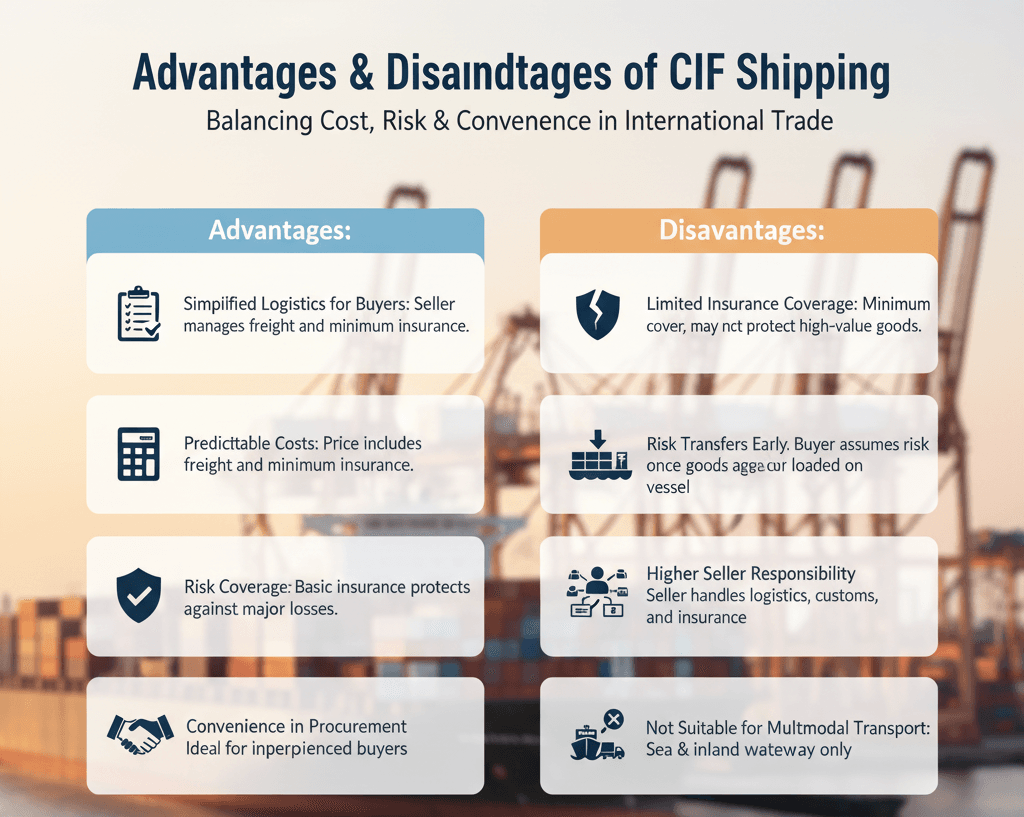 CIF (Cost, Insurance, and Freight) offers several benefits and some limitations for international trade. Understanding these helps businesses choose the right shipping arrangement.
CIF (Cost, Insurance, and Freight) offers several benefits and some limitations for international trade. Understanding these helps businesses choose the right shipping arrangement.
Advantages:
- Simplified Logistics for Buyers: The seller manages freight and minimum insurance, reducing buyer’s administrative burden.
- Predictable Costs: CIF clearly defines costs included in the price, aiding budgeting and financial planning.
- Risk Coverage: Basic insurance protects the buyer against major losses or damages during transit.
- Convenience in Procurement: Especially suitable for buyers who lack experience in international shipping or insurance arrangements.
Disadvantages:
- Limited Insurance Coverage: Sellers provide only minimum insurance, which may not cover high-value or fragile goods.
- Risk Transfers Early: Risk passes to the buyer once goods are loaded on the vessel, even if transit is long or complex.
- Higher Seller Responsibility: Sellers must handle export clearance, freight arrangements, and insurance, increasing their administrative workload.
- Not Suitable for Multimodal Transport: CIF is restricted to sea and inland waterway shipments only.
Common Pitfalls & Risk Mitigation in CIF Contracts
Even though CIF (Cost, Insurance, and Freight) simplifies international shipping, both buyers and sellers must be aware of common pitfalls to minimize risks:
Common Pitfalls:
- Assuming Full Insurance Coverage: Buyers often mistakenly believe CIF covers all risks, but sellers only provide minimum insurance.
- Misunderstanding Risk Transfer: Risk passes to the buyer once goods are loaded onto the vessel, not at the destination port.
- Incomplete Documentation: Missing or inaccurate Bill of Lading, insurance certificates, or commercial invoices can delay customs clearance.
- Hidden Costs: Buyers may overlook port handling fees, unloading charges, or additional insurance costs, assuming CIF covers everything.
Risk Mitigation Strategies:
- Verify Insurance Terms: Buyers should review the policy coverage and consider supplemental insurance for high-value or fragile cargo.
- Clarify Contractual Obligations: Clearly define delivery terms, documentation responsibilities, and freight details in the contract.
- Use Experienced Freight Forwarders: Partnering with reliable logistics providers helps ensure smooth loading, transport, and customs clearance.
- Track Shipments Proactively: Monitor vessel departures, transit, and estimated arrival to minimize delays or losses.
Case Study: Practical Example of CIF Shipping
Scenario: A company in the USA imports electronics from China under CIF terms.
Details:
- Goods Value: $50,000
- Freight Cost: $5,000
- Insurance Premium (minimum coverage): $500
- Port of Shipment: Shanghai
- Destination Port: Los Angeles
Calculation of CIF Price:
| Component / Responsibility | Details / Cost (USD) |
|---|---|
| Goods Value | 50,000 |
| Freight | 5,000 |
| Insurance (minimum coverage) | 500 |
| Total CIF Price | 55,500 |
| Seller Responsibilities | – Deliver goods onboard vessel at Shanghai – Pay freight and arrange minimum insurance to Los Angeles – Provide Bill of Lading, insurance certificate, and invoice |
| Buyer Responsibilities | – Risk transfers once goods are loaded on vessel – Pay import duties, taxes, unloading, and inland transport – Optionally purchase additional insurance |
Responsibilities:
Seller:
- Delivers goods onboard the vessel in Shanghai
- Pays freight and arranges minimum insurance to Los Angeles
- Provides Bill of Lading, insurance certificate, and commercial invoice
Buyer:
- Assumes risk once goods are loaded on the vessel
- Pays import duties, taxes, unloading, and inland transport
- May choose to purchase additional insurance for better coverage
Outcome:
Buyer pays $55,500 CIF, while the seller covers shipping and insurance.
Risk of loss or damage during transit is transferred at loading, so the buyer must monitor and possibly insure further.
Final Review
CIF Incoterms provide a practical and widely accepted framework for international shipping by clearly defining costs, risks, and responsibilities between sellers and buyers.
While it offers convenience and predictability, businesses must understand the point of risk transfer, insurance limitations, and documentation requirements, especially when selecting the most efficient shipping routes and shipping methods for their cargo.
By applying CIF thoughtfully, companies can streamline their shipping operations, protect their goods, and optimize their transport strategies, making it a reliable choice for sea and inland waterway shipments across global trade routes.
FAQ CIF Incoterms
Who pays freight in CIF?
The seller pays the freight to transport goods to the destination port under CIF terms.
What is the risk transfer for CIF?
Risk transfers from the seller to the buyer once the goods are loaded on the vessel at the port of shipment.
How to calculate CIF cost?
CIF = Cost of goods + Insurance + Freight charges to the destination port.
Who pays duties and taxes on CIF?
The buyer is responsible for import duties and taxes at the destination.
Who pays for freight charges?
Under CIF, the seller pays all freight charges to the destination port.
Who pays freight in CFR Incoterm?
In CFR, the seller also pays freight costs, but insurance is not included.
Who will pay freight in CIF?
The seller pays the freight cost to the destination port.
Who pays duty in CIF Incoterms?
The buyer pays all import duties and customs charges.
When should I use CIF Incoterms?
Use CIF when the seller has better access to shipping arrangements and you prefer less logistics handling.
Which is better, CIF or FOB?
CIF favors sellers, while FOB (Free On Board) gives buyers more control and transparency in shipping costs.
Do CIF prices include tariffs?
No, tariffs or import duties are not included in CIF pricing.
Is CIF a good choice for buyers?
CIF can be convenient, but buyers have limited control over shipping and insurance details.
What are the risks of using CIF?
Buyers face risks from limited control over carriers, potential overpricing, and low insurance coverage.
Who clears customs in CIF?
The buyer handles import customs clearance at the destination.
Who is responsible for clearing customs?
The seller clears export customs; the buyer clears import customs.
Who is responsible for customs clearance under CIP?
Under CIP, the seller clears export customs, and the buyer manages import customs clearance.
Who pays import duty on CIF?
The buyer pays all import duties and taxes upon arrival.
